San Bernardino County Supervisors Vote Against Soda Mountain Solar Project
August 24, 2016 - San Bernardino CA - At a meeting yesterday well-attended by desert activists, County Supervisors gathered to vote 3-2 against giving premits to the unpopular Soda Mountain Solar Project. Here is a wrap-up of articles:
http://www.mojavedesertblog.com/2016/08/county-rejects-environmental.html
http://www.latimes.com/local/california/la-me-soda-mountain-solar-20160824-snap-story.html
http://www.nationalparkstraveler.com/2016/08/soda-mountain-solar-project-fails-get-key-permits
http://www.inlandnewstoday.com/story.php?s=43280
Bechtel Sells Project
August 17, 2016 - Bechtel, the multinational company that had previously purchased the Soda Mountain Solar Project from another entity, this month sold the project to developer Regenerate Power (http://www.regeneratepowerllc.com).
San Bernardino County Supervisors to Decide in Meeting on Project

July 21, 2016 - The next meeting of the County Supervisors will be on August 23, where they will consider the Environmental Impact Report under the California Environmental Quality Act review for the Soda Mountain Solar Energy Project. Please consider attending and making your voice heard.
See the Call to Action on the Morongo Basin Conservation Association and write a letter to the Supervicors.
Sign the Petition by Alliance for Desert Preservation.
Basin & Range Watch's Letter to San Bernardino County:
Basin and Range Watch
June 21, 2016
To: San Bernardino County Supervisors:
Robert Lovingood (First District Supervisor)
Email: Supervisorlovingood@sbcounty.gov
Janice Rutherford (Second District Supervisor)
Email: SupervisorRutherford@sbcounty.gov
Supervisor James Ramos (Third District Supervisor)
Email: SupervisorRamos@sbcounty.gov
Supervisor Curt Hagman (Fourth District Supervisor)
Email: SupervisorHagman@sbcounty.gov
Supervisor Josie Gonzales (Fifth District Supervisor)
Email: SupervisorHagman@sbcounty.gov
Subject: Deny the Soda Mountain Solar Project
Basin and Range Watch is a 501(c)(3) non-profit working to conserve the deserts of Nevada and California and to educate the public about the diversity of life, culture, and history of the ecosystems and wild lands of the desert. Federal and many state agencies are seeking to open up millions of acres of unspoiled habitat and public land in our region to energy development. Our goal is to identify the problems of energy sprawl and find solutions that will preserve our natural ecosystems, open spaces, and quality of life for local communities. We support energy efficiency, better rooftop solar policy, and distributed generation/storage alternatives, as well as local, state and national planning for wise energy and land use following the principles of conservation biology.
The Soda Mountain Solar Project will create a very large gaping scar in the Mojave Desert on land located approximately one quarter mile from the border of the Mojave National Preserve. As you are aware, the project would impact one of the most important populations of desert bighorn sheep in California. The mitigation efforts to build a bridge across the highway are experimental at best.
The project will also be using a very large amount of groundwater for dust mitigation during construction and additional water for panel cleaning during the project lifespan. The hydrology in the region is poorly understood. A solar project of this size traditionally uses 1,000 to 2,000 acre feet of water during construction and this one could use over 40 acre feet a year for solar panel washing. While Bechtel claims they will use about 600 acre feet, that is inconsistent with over large scale PV projects which have used triple that amount during construction. The aquifer is poorly understood and the lack of higher mountains in the area indicate that there is little recharge from precipitation. Desert aquifers are delicate and in many ways irreplaceable. This water supplies the Soda Springs complex and if it is removed, the Mojave tui chub which is endangered could be threatened with potential decline.
The project is six miles from Baker and right next to Zzyzx Desert Studies Center. Large-scale solar projects in the desert create dust and developers have a hard time controlling it for years after they bulldoze 3 square miles. In its review, the Bureau of Land Management swept the dust issue under the rug. The below quote if from the Draft EIS by BLM:
“The Project site is not within the immediate vicinity of non-residential sensitive receptors (e.g., schools, hospitals, daycare centers, long-term care facilities). The closest schools are Baker Elementary, Middle, and High Schools, which are all over 6.5 miles from the Project site, in the northeastern portion of the town of Baker. The closest residences to the Project site are located adjacent to the service station on Rasor Road, approximately 230 feet southwest of the requested Project ROW (see Figure 3.2-1, which shows residence locations). The residences include a single-family residence and workforce housing for four employees.”
In the Mojave Desert, fugitive dust travels further than 6.5 miles. Baker may be a small town, but over 700 people live there and fugitive dust could threaten health. Coccidioidomycosis (Valley Fever) is a common issue that impacts desert communities when dust is stirred up.
The visual impacts the region would be unavoidable. The BLM mitigation to site the project differently to mitigate visual impacts is meaningless. How can you hide a nearly 2,000 acre solar project? You can’t. The project will be visible for miles, from the Soda Mountains and the Devil’s Playground in the Mojave National Preserve. The dust plumes during construction will also be visible. Huge desert scrape, transmission hookups, glaring solar panels, new roads etc. will all degrade the natural view. Night lighting will take away from the dark sky. San Bernardino County has a tourism future with its natural scenery, but it is a tourism dead end to approve solar projects that destroy so much of the view.
The county has submitted a letter for the Desert Renewable Energy Conservation Plan
requesting conservation and preservation of the scenery. San Bernardino County is huge with a population of 2.11 million people. Huge population centers like Redlands have so many rooftops, you could equal the power of 50 Soda Mountain Solar projects! There are 11,880 buildings in San Bernardino County totaling approximately 8,400 acres under roof and almost none of these utilize solar for electricity. These same roofs could have solar panels installed and would generate over 1,400 MW of electricity. Rooftop solar and good energy conservation practices in the county make the need for the Soda Mountain Solar Project obsolete.
For the DRECP, this project would be located on the BLM’s “Unallocated Lands” and
Development Focus Areas in San Bernardino County, which make up over 350,000 acres in San Bernardino County. A vast majority of these lands are rural living areas and conservation areas. The DRECP has poorly defined unallocated lands and has done a poor job of describing them. The County has told the BLM that this project area and other areas are not suitable for largescale solar energy, and to locate projects only in those areas identified as suitable by the County.
The County should be asking to implement the California Energy Efficiency Strategic Plan
(CEESP). This plan already exists as California state law and it can be fully implemented now. For more background see www.basinandrangewatch.org/DRECP-CEESP-Alternative.html It is a state plan that prioritizes implementing rooftop solar and energy efficiency prior to developing largescale, remote solar and wind projects. For more background see www.basinandrangewatch.org/DRECP-CEESP-Alternative.html It is a state plan that prioritizes implementing rooftop solar and energy efficiency prior to developing large-scale, remote solar and wind projects.
Most oppose this project because they oppose the federal overreach or “power grab” on the part of the BLM (Department of Interior). This is undermining the County’s Zoning and Natural Resources authority.
The only transmission hookup is owned by the Los Angeles Department of Water and Power (LADWP). As you are aware, LADWP has refused to purchase power from this project because of the destructive impacts it will have on the Mojave Desert and the Mojave National Preserve. While the BLM is aware of LADWP’s position, they still approved the project. San Bernardino County has an opportunity to stop this project.
Significant harm to the local community, county tourism and the Mojave National Preserve would take place. The average large-scale photovoltaic project only creates about 10 to 20 fulltime jobs. Construction usually only creates a boom and bust effect and the scenery is compromised afterwards. This is not a good long-term project for the county.
Conclusion: The Soda Mountain Solar Project is wrong for San Bernardino County. Smart economic growth should celebrate the spectacular natural scenery and promote tourism - not exploit a large amount of land a resources for short-term economic gain for one corporation. Please deny this ill-conceived project.
Thank you,
Laura Cunningham
Executive Director
Basin and Range Watch
Kevin Emmerich, Co-Founder, Basin and Range Watch
Cima, CA
Interior Department Approves Project Despite Opposition and Lack of Need
April 6, 2016 - The Interior Department approved the Soda Mountain Solar Energy Project next to the Mojave National Preserve against great public opposition. The project was reduced to 287 megawatts, on 1,767 acres of Bureau of Land Managament lands about six miles southwest of Baker, California. This was reduced from an originally proposed 2,222 acres. Yet Interior calls this site "disturbed," yet it is largely Mojave Desert creosote-bursage ecosystems, with areas of undistrurbed sand sheets and desert rock pavement. We have visited the site numerous times and witnessed beautiful wildflowers displays across the site.
BLM says: "The BLM’s approved design removes an array of solar panels originally proposed for north of the interstate highway, eliminating virtually all visual impacts from the project within neighboring Mojave National Preserve. The project would not be seen from most parts of the Preserve, including from any highway or established route of travel within the Preserve."
Yet the solar project would be highly visible from the hills within the Preserve around Zzyzx, so this project modification would not "eliminate" visual impacts to the park unit. In fact, the solar panels closest to the preserve boundary have been retained.
This area has been mapped as a significant genetic corridor for bighorn sheep across the Mojave Desert, and mitigation for blocking it will apparently be deferred until later, with little public review, as a "bighorn sheep adaptive management strategy to maintain existing foraging, movement and feeding opportunities..." will be develpoed later.
Groundwater studies remain controversial as pumping will be needed during construction and operation so close to highly rare and local Mojave tui chub populations nearby.
A potential issue here is that BLM accepted an amended Plan of Development for the project AFTER the comment/protest period for the Final Environmental Impact Statement closed. That is a new plan and it can be argued that the public never got to review or comment on that.
From the Record of Decision:
2.4 Information Developed since the Proposed PA and Final EIS/EIR
Since the preparation and publication of the Proposed P A Final EIS/EIR, the Applicant has submitted an Amended Plan ofDevelopment (POD) providing new information consisting of clarifications on the design of Alternative B. This new information, described below, did not result in significant modifications to the Selected Alternative or require additional NEP A analysis.
The project has no Power Purhcase Agreement, and transmission access is in question.
http://losangeles.cbslocal.com/2016/04/05/feds-approve-287-megawatt-solar-plant-in-mojave-desert/
http://www.blm.gov/wo/st/en/info/newsroom/2016/april/nr_04_05_2016.html
Los Angeles Does Not Want Power From Soda Mountain Project
June 12, 2015 - In a surprising development, Los Angeles Department of Water and Power (LADWP), the main utility that would purchase electricity from the Soda Mountain Solar Project, said Thursday the project would be too damaging to bighorn sheep and cost too much. LADWP owns the existing transmission lines that run through the valley. Bechtel, the company wishing to construct this project, said it would seek other utilities.
See the Los Angeles Times: http://www.latimes.com/local/california/la-me-solar-20150612-story.html
Moving Towards Approval: Final EIS Out
June 6, 2015 - San Bernardino County CA - The Bureau of Land Management (BLM) released the Final Environmental Impact Statement (FEIS), moving a step closer to approval and a Record of Decision which would allow the company Bechtel to build a 3-square mile photovoltaic project next to the boundary of the Mojave National Preserve, depsite objections by environmentalists and supportrs of the park unit. This project was one of the most strongly opposed large-scale projects in the desert since it will impact the beloved Preserve and hinder bighorn sheep movement between mountain ranges.
Mitigation is feeble, reducing the size of the project, setting aside funds for a potential overpass for sheep to cross the project and Interstate-15, as well as build drinking guzzlers for sheep.
See The Press Enterprise.
See the Final EIS on the BLM web page:
http://www.blm.gov/ca/st/en/fo/barstow/renewableenergy/soda_mountain.html
See the National Parks and Conservation Association page on the project and a proposal for an Area of Critical Environmental Concern >>here.
Soda Mountain Solar Project Protest
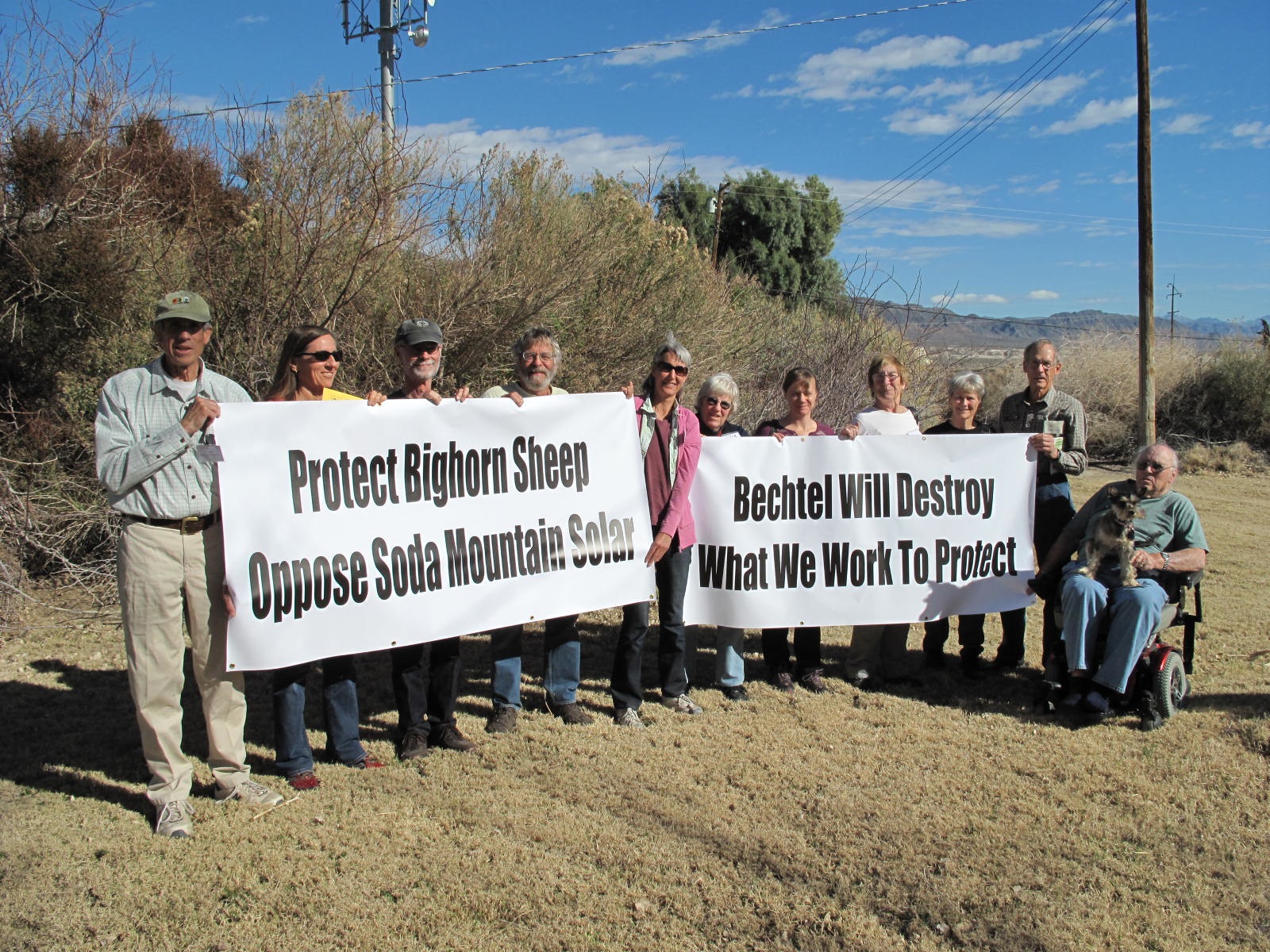
February 14, 2015 - California/Nevada Desert Committee members protest Soda Mountain Solar, a Bechtel proposed project that will disrupt bighorn sheep migration and damage burrowing owl, kit fox and desert tortoise habitat.
Bighorn Sheep Experts Say Project Would Harm Connectivity
January 13, 2015 - Two noted wildlife biologists have written a column describing how important the Soda Mountain valley is for bighorn sheep connectivity. John Wehausen, Ph.D., an applied population ecologist who has studied bighorn sheep populations in California since 1974, and Clinton Epps, Ph.D., an associate professor at Oregon State University who specializes in mammal conservation.
They write, "The proposed Soda Mountain Solar Project would straddle Interstate 15 and cover areas between the north and south Soda Mountains on the northwestern edge of the Mojave National Preserve, pinching off the best location to re-establish important bighorn sheep movements that have been severed by I-15. The proposed development, which would include solar arrays, infrastructure and roads, would likely prevent bighorn from moving through the project area."
The broad connection between bighorn populations in Mojave National Preserve and Death Valley National Park could be impacted by cutting off the already tenuous movement corridors between these areas, say the biologists:
"Our research finds that the Soda Mountains connection is a particularly important restorable corridor in the southeastern desert region of California, where a wildlife overpass would re-establish migration affecting numerous bighorn sheep populations on either side of I-15."
They emphasize, "While we recognize the importance of investing in a renewable energy future that buffers us from the worst impacts of climate change and enhances our nation’s energy independence, we strongly believe that this can be done in a manner that does not jeopardize the ecological integrity of our national parks, wilderness areas and wildlife."
See more at The Daily Bulletin.
Sign the Petition to Ask the White House to Protect Mojave National Preserve
February 17, 2014 - Bechtel proposes to build Soda Mountain Solar on 4,179 acres of public land adjacent to Mojave National Preserve, threatening the resources and landscape of this treasured unit of the National Park System.
Sign the Petition at https://petitions.whitehouse.gov/petition/protect-mojave-national-preserve-denying-bechtels-request-public-land-grant-build-its-soda-mountain/QVjW78fy
The Soda Mountain project will interfere markedly with the habitat corridor linking Joshua Tree and Death Valley National Parks.
The environmental impacts of Soda Mountain include decreased spring discharge at Zzyzx, loss of habitat for the endangered Mohave tui chub, loss of high-quality desert tortoise habitat, increased habitat fragmentation for desert bighorn sheep, and loss of wildlife connectivity with nearby wilderness areas.
Soda Mountain will obstruct dramatic views into the Preserve and degrade the dark skies experience of the park's 550,000 annual visitors.
You will need to quickly create an account, then follow the instructions in the White House email you receive. We are hoping for at least 150 signatures in 30 days to make the petition publicly searchable.
You can also email the developer Bechtel to urge them to withdraw their application for a right-of-way to construct a solar project on public land adjacent to the park.
Overwhelming Opposition to Soda Mountain Solar Project
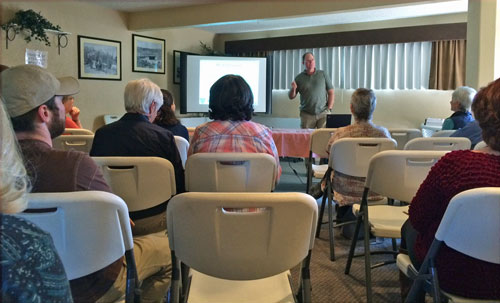
January 12, 2014 - Yucca Valley CA - The Bureau of Land Management held a public meeting in Yucca Valley yesterday, and about 30 people showed up, and many made comments. Representatives from applicant Bechtel were also present. Many local residents and environmental groups opposed this project because it is in the wrong place: within a mile of the Mojave National Preserve, a beloved park unit in the heart of the desert. The project also would block important desert bighorn sheep connectivity between mountain ranges.
The project has a long history, first proposed in 2008 by a company called Caithness, with a larger footprint. The project was revised in 2009 to avoid washes. In 2011 the north array was shrunk back to avoid a pinch point of a utility corridor to the southwest. Now that Bechtel has purchased the project the right-of-way (ROW) is 4,179 acres, with the actual solar array being 2,165 acres. Fences will be around individual arrays and not whole ROW; washes would be open for bighorn sheep movement. Bechtel pulled back the north array in the west to avoid a local population of the rare shrub Emory's crucifixion thorn.
Bechtel said they chose the site because of two existing transmission lines and easy vehicular access during construction. They claimed "low environmental sensitivity."
The project would take 2-3 years to construct.
Deadline for comments March 3.


^Two panoramas taken of the Soda Mountain project site by Michael E. Gordon (see www.michael-gordon.com)
Public Comments
A union representative spoke in support of the project, but nearly all other comments were in opposition.
A Joshua Tree resident commented on owning a cultural center which relies on tourism, tourists traveling between parks, and much international tourism. She talked of "deeply spiritual cultural resources that you know if you have lived here a long time." The economic importance should be realized -- there is a need for long term jobs, long term thinking she said.
Local conservationist Claudia Sall spoke of the 60 acre-feet of water per year that will be estimated to be used on the project. She said there is nothing in place for groundwater reports, threshold points for any lowering of the water table. A new ordinance in the county means this project would not fly today. The ordinance limits visual and wildlife impacts within two miles of parks. She pointed out how the posters of maps of the project in the room did not show the park boundary, or wilderness areas.
David Lamfrom of the Mojave National Preserve Conservancy said the project has no Power Purchase Agreement so the project could be moved, the jobs moved. All major environmental groups wrote letter opposing this project, so this solar project is more widely opposed than most, he said. The original Caithness project was deprioritized over bighorn sheep conflicts, and not included in the Desert Renewable Energy Conservation Plan (DRECP) planning process and maps. When Bechtel bought the project it was prioritized again and placed back on DRECP maps. But it is not in a solar zone under the Solar Programmatic Environmental Impact Statement developed by the Department of the Interior. "Why is there not an alternative placing it in a zone? Millions of dollars of planning are being ignored," Lamfrom said. he also pointed out that one existing transmission line is full, and it is not certain if the other line owned by Los Angeles Department of Water and Power is available. He requested the public speak to the county if you are a land owner or a business owner.
Los Angeles resident and long-time desert activisit Tom Budlong explained that the National Environmental Policy Act (under which the BLM reviews projects on public land) directs that project proposals must have other reasonable alternatives, not necessarily in the technical expertise of the applicant. Rooftop solar alternatives, Central Valley alternative, smaller projects in other locations should be analyzed. "I think this meeting will disappear into the sands like a glass of water," he said, since the BLM was not recording public oral comments any longer.
Seth Shteir of the National Parks Cconservation Association opposed the project at this location and asked to move it. This is the closest project to a national park he knew about, less than a mile from the Mojave National Preserve. The Preserve is the third largest national park unit in lower the 48 states, with 500,000 visitors per year. The Purpose and Need statement in BLM's environmental review document was lacking, he said. It is too narrow, resulting also in a narrow range of alternatives. The project conflicts with the recent renewable energy ordinance passed by San Bernardino County that within 2 miles of a park there shall not be a project that distracts from visual resources. there is uncertainty about water impacts to the federally endangered Mojave tui chub in nearby Soda Springs. "It is hard to believe bighorn sheep will weave their way through the solar arrays," he said. Desert sheep biologist John Wehausen says this is an important connectivity corridor, between the Soda Mountains and Cady Mountains. He asked to extend comment period 60 days.
Joan Taylor of the Sierra Club said we need to support sustainable renewable energy. The Sierra Club says this site is very inappropriate. The lake effect of the shiny solar panels may draw in birds. A BLM boiler plate process is not efficient, the alternatives are not sufficient legally. The state is ahead in its Renwable Portfolio Standard goals so this project is not a priority. Local rooftop solar provides sustainable jobs. "This is the Last Frontier," she said.
Terry Weiner of the Desert Protective Council talked of the beauty, and stunning open and wild areas where people visit, hike, and camp in the California Desert. Any "multiplier effect" of solar project jobs does not take into account the loss of tourism jobs she pointed out.
Fraser Haney of the Mojave Land Trust commented on how many land trusts, including his own, have purchased private land inholdings given to the BLM for conservation. The Wildlands Conservancy had purhcased old Catellus lands for this reason. Hundreds of thousands of acres were given to protect connectivity between parks and core areas of the desert. This site is unsuitable for any commercial development he said.
Other comments mentioned that the BLM should hold public meetings in Las Vegas, NV for any projects impacting the Mojave National Preserve since it is a close city.
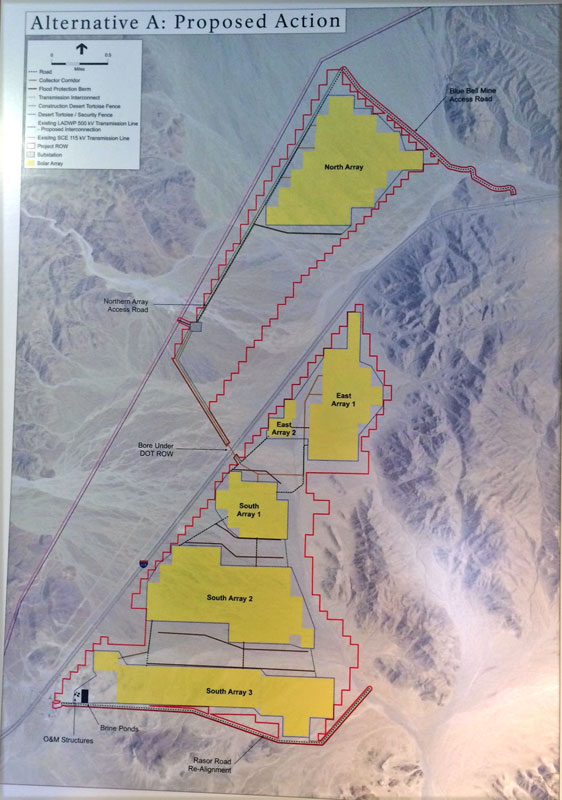
^The BLM generated three alternatives. This map shows Alternative A which is the is proponent's preferred layout. Three No Action alternatives were also generated; one leave the site open for other solar projects and another No Action alternative closes the site to future solar projects.
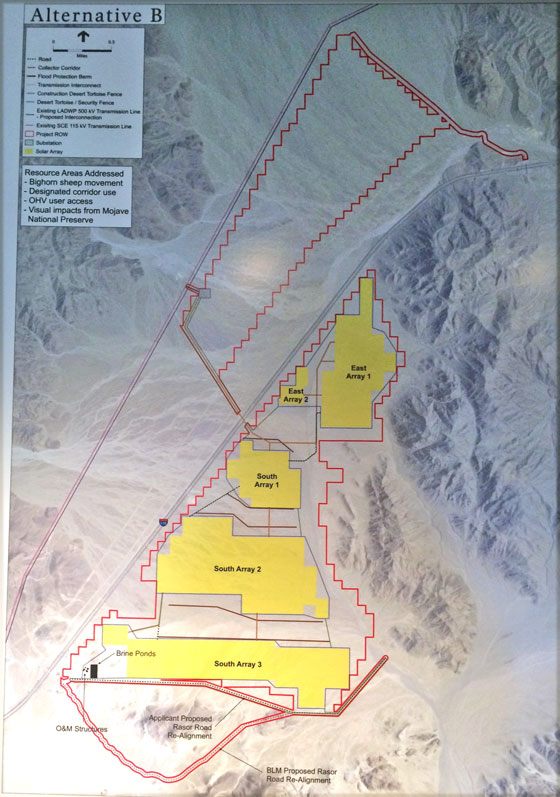
^Alternative B accommodates transmission, petroleum pipelines, and other linear ROWs. The proposed Xpress West high-speed train ROW was negotiated along the Interstate-15 highway as well.
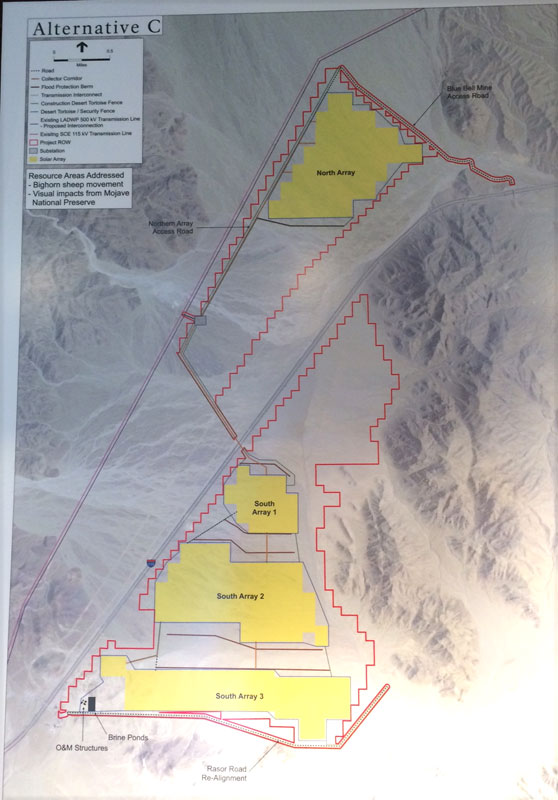
^Alternative C removes the East 1 and 2 arrays where live desert tortoises were found.
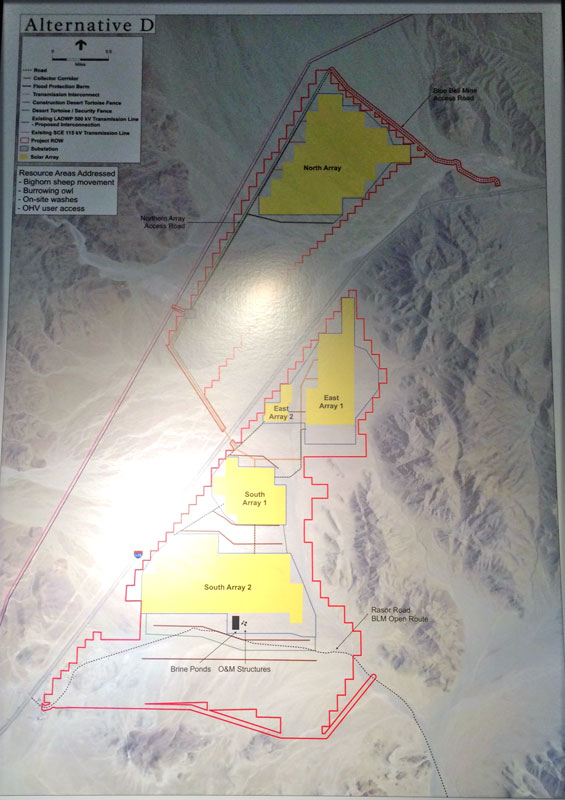
^Alternative D accomodates more off-road vehicle use in the southwest part of the valley.
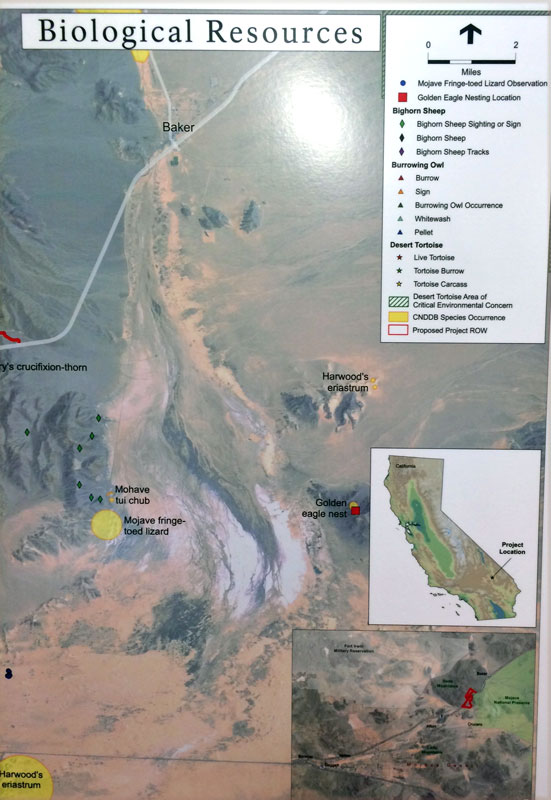
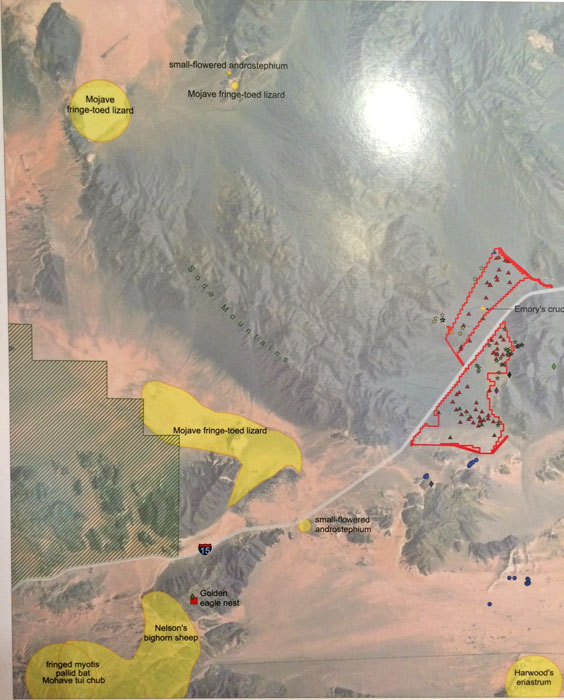
^Maps showing biological resources (left and right sides of poster) -- (see key below and detail photo enlarged). Note how the map leaves out the important boundary of the Mojave National Preserve which is just to the south and east of the project. This information should be made plain to public view.
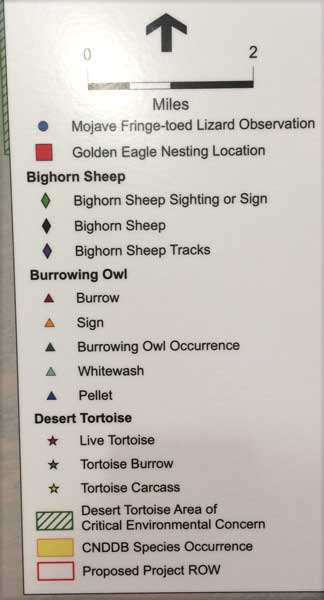
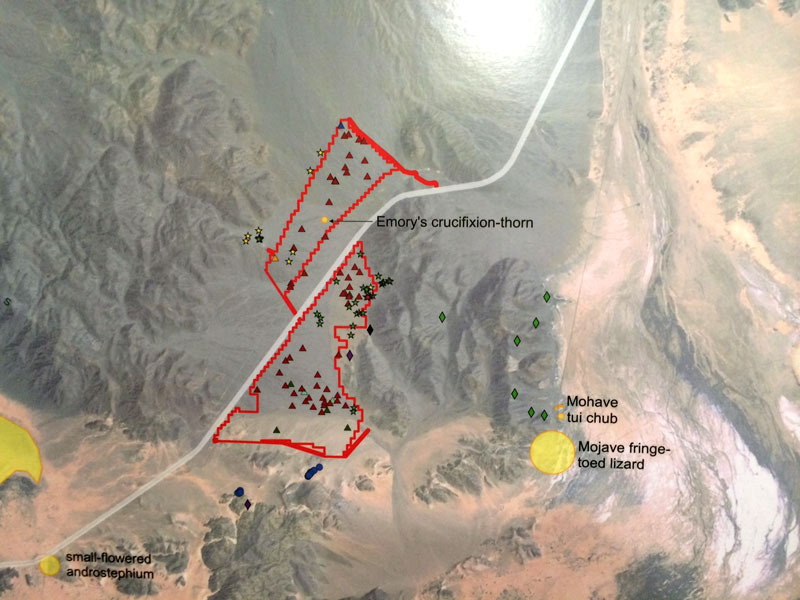
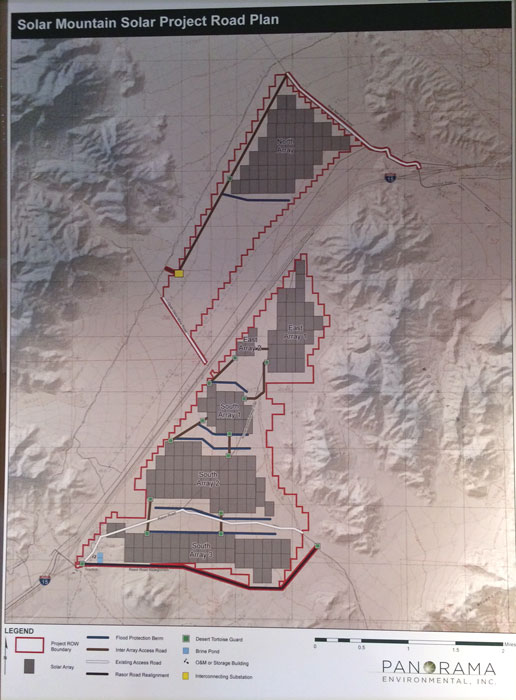
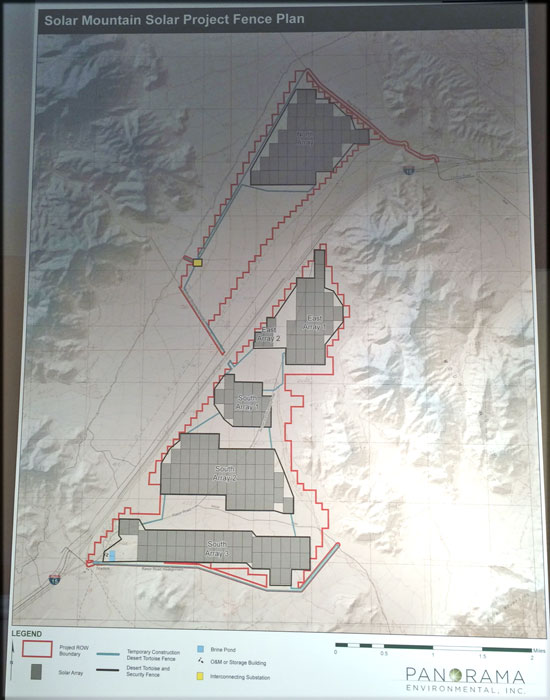
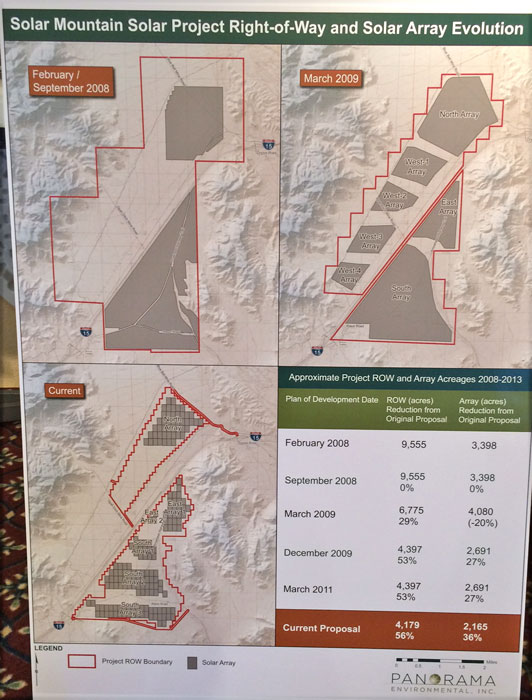
Public Meetings Announced
UPDATE: December 20, 2013 - The Bureau of Land Management has scheduled an additional public meeting for public comment on the Soda Mountain Solar Project's draft environmental document. The meeting is scheduled for Saturday, Jan. 11, 2014, from 1 p.m. to 4 p.m. at the Travelodge Inn and Suites Yucca Valley Meeting Room, 54850 29 Palms Highway, Yucca Valley.
December 15, 2013 - The Bureau of Land Management has scheduled public meetings on Jan. 8- 9, 2014 in Barstow, CA.
The BLM has scheduled two public meetings for public comment on the Soda Mountain Solar Project's draft environmental documents. Meetings are scheduled for Wednesday, Jan. 8, 2014, from 6 p.m. to 9 p.m. and Thursday, Jan. 9, 2014, from 1 p.m. to 4 p.m. at the Comfort Suites, 2571 Fisher Blvd., Barstow.
http://www.blm.gov/ca/st/en/info/newsroom/2013/december/CDD-14-14-SodaMountain.html
Soda Mountain Solar Project Environmental Review Released
December 8, 2013 - The Notice of Availability of the Draft Environmental Impact Statement was published on November 29, 2013, for the photovoltaic project that may be as large as 359 megawatts on 4,179 acres of public land with intact Mojave Desert scrub and wash habitats.
Public Comment: Publication of the NOA initiates a public comment period open until March 3, 2014.
http://www.blm.gov/ca/st/en/fo/barstow/renewableenergy/soda_mountain.html
New Map
June 6, 2013 - >>here.
Scoping Period Opens for Soda Mountain Solar Project
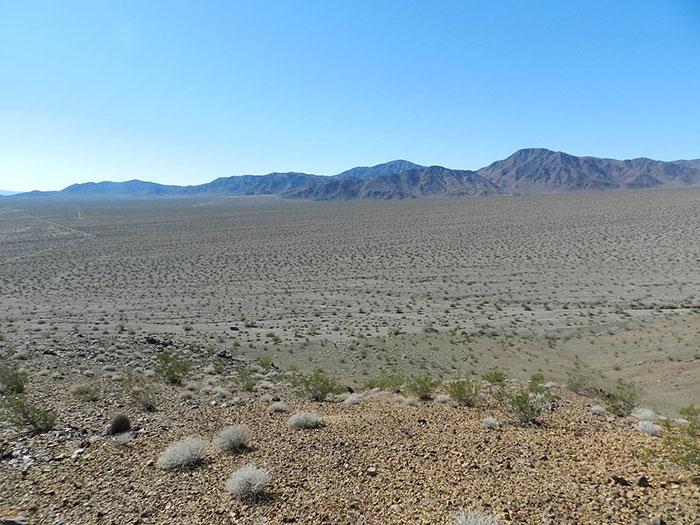
^View looking west from the Soda Mountains onto the proposed north array of the solar project.
October 23, 2012 - In the Federal Register, a Notice of Intent To Prepare an Environmental Impact Statement, a Possible Land Use Plan Amendment, and a Public Lands Segregation for the Proposed Soda Mountain Solar Project, San Bernardino County, California: http://www.gpo.gov/fdsys/pkg/FR-2012-10-23/html/2012-26046.htm
This project proposes to replace 2,691 acres of Mojave Desert with photovoltaic panels. It will be located on habitat for the Mojave fringe-toed lizard and it will also remove several mesquite trees.
The Bureau of Land Management is only giving one month to comment on this. November 8 is a tentative date for public scoping meetings. See the BLM website: http://www.blm.gov/ca/st/en/fo/cdd.html
The notice reads: The applicant, Soda Mountain Solar, LLC, has requested a right-of-way (ROW) authorization to construct, operate, maintain and decommission a maximum 350 megawatt (MW) photovoltaic facility and necessary ancillary facilities, including a project substation, access road, realignment of an existing designated route (Rasor Road), operations and maintenance buildings, and lay down areas. The project is proposed on 4,397 acres with the solar field occupying approximately 2,691 acres. This Notice informs the public that the BLM intends to prepare a Draft CDCA Plan amendment and associated EIS/EIR with San Bernardino County for the Project and announces the beginning of the scoping process to seek public input on environmental issues and planning criteria.
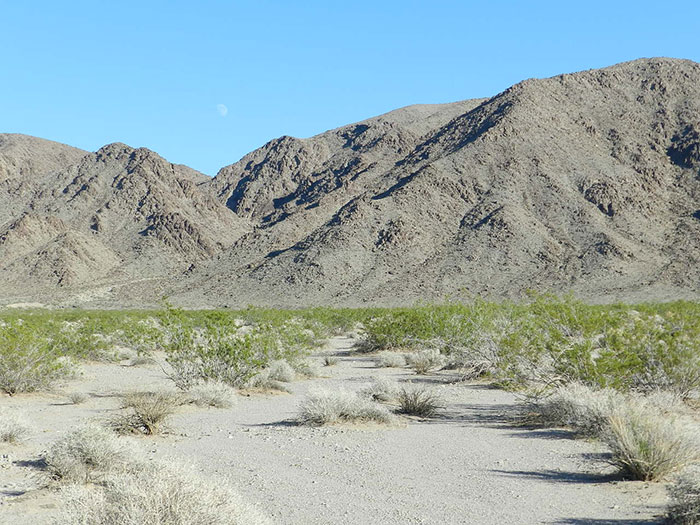
^Part of the east array of the proposed solar project, south of Interstate 15.
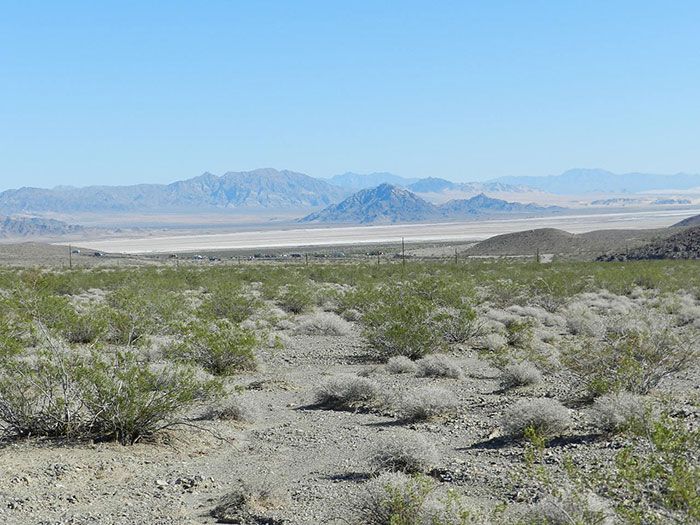
^View from the proposed north array solar field, looking southeast towards Soda Dry Lake, and the Devil's Playground, Cowhole Mountains, and Granite Mountains in Mojave National Preserve.
^Chinchweed (Pectis papposa), flowering after the late summer and fall rains across the Mojave Desert. Near the north array on the base of the Soda Mountains.
^Smoke trees next to the north array.
^The proposed solar field of the north array, in creosote-bursage desert. The alluvial fan coming off the Soda Mountains looks active when rains wash down the slopes.
^View in the Soda Mountains looking west across the alluvial fan where the north array is mapped to be sited if the project is approved.
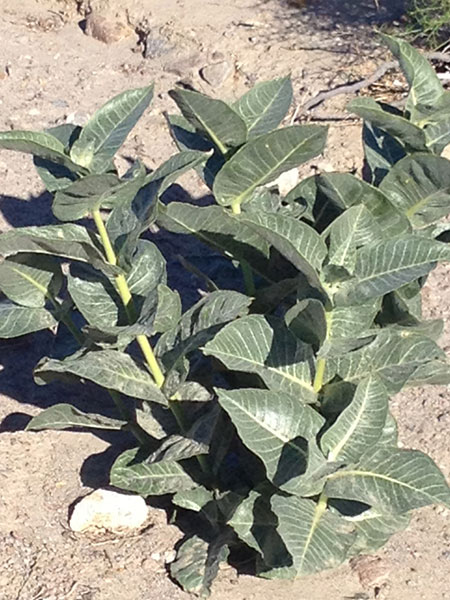
^A large-leaved milkweed (Asclepias sp.) grows in October on the west array project site near Rasor Road.
^We have never seen so many grasshoppers in the creosote desert, the summer and fall rains have caused a hatch of hundreds of herbivorous insects taking advantage of the new green vegetation. This band-winged grasshopper (family Oedipodinae) had clear wings as it flew, with a hint of yellow. Dozens flew at each step we took walking across the desert here.
^Green creosote on a less active fan in the proposed east array solar field, looking southeast towards Springer Mountain. The Zzyzzx area and Soda Springs lies on the other side of the range.
^Boundary of the open area designated by Bureau of Land Management along Rasor Road south of Highway 15. This view looks northward into the south array from the Rasor OHV Area.
^View looking from the southern margin of the south array solar field proposal into the Rasor OHV Area along Rasor Road. In the distance is a large sand blow-up that harbors a good population of Mojave fringe-toed lizards (Uma scoparia). These lizards have been reported to cross Rasor Road in this spot where the photo was taken as well.

^Mojave fringe-toed lizard (Uma scoparia).
Solar Project Would Lie Close to Mojave National Preserve Boundary
Caithness Soda Mountains Solar Energy Project
July 16, 2011 - San Bernardino County, California - Caithness Soda Mountains Solar Energy Project located about 20 miles west of Baker, California, in the Mojave Desert would remove 3,000 acres of Mojave Desert habitat and replace it with 1.5 million photovoltaic panels. Sand blowups near the site support Mojave fringe-toed lizards (Uma scoparia). The project is still in the planning stages and the Bureau of Land Management has not officially announced it yet.
Caithness had a promotinal description on their website, accessed July 2011 (http://www.caithnessenergy.com/Caithness-Projects-Soda-Mountain.php - the link has since borken and this site apparently no longer exists)
"The Caithness Soda Mountain Solar Project is solar photovoltaic power generating facility located in the Mojave Desert in southern California. The project will employ 1.5 million solar panels mounted on a one-axis tracking system to generate 350 MW of electricity. It will be sited on approximately 3000 acres of land managed by the Bureau of Land Management. The valley in which the project is located already has multiple utility and vehicular corridors running through it. The high level of insolation, existing high voltage electric transmission lines, excellent vehicular access and the pre-existing industrial uses of the area make this a particularly suitable site for solar power development. This project will help the state of California meet its goals for greatly expanding the use of renewable energy with minimal impact on the desert environment."
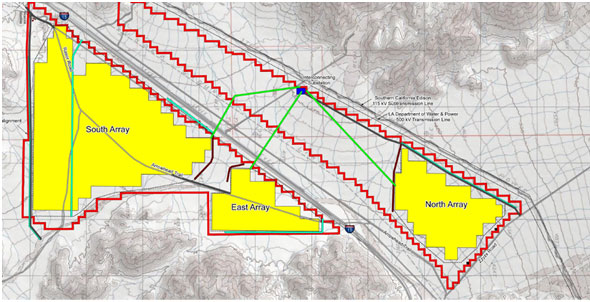
^Map of proposed project on either side of Interstate 15, west of Baker, California.
Plan of Development
Download the 16.4 MB PDF file >>here.
HOME.....June 2013 Map
